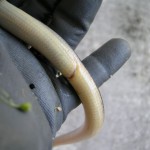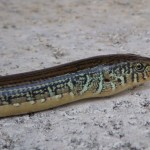It was a dry winter here in subtropical Florida, with quite a bit less rain than normal since November. The temperatures haven’t been too unbearable, but the weekend before Easter brought a taste of summer: mid-80s, humid, and plenty of sun. That weekend also happened to be one of the few that I had time to get my hands a little bit dirty in the garden. So, there I was, weeding the cocoplum/palm/oak islands in the front yard. And then, when I couldn’t take it any longer and moved over to a shady corner of the house, I discovered an Eastern Glass Lizard (Ophisaurus ventralis) hanging out in the cocoplum.
As you can see from the picture, I was actually getting my gloved hands dirty:

Readers of this blog may remember that finding a glass lizard is a fairly rare occurrence around our house; I’d only seen one of these little beasties previously.
One of the interesting things about this lizard is that it is, or seems to be, almost all tail. As you know, most lizards have the peculiar ability to drop their tail when threatened; the thrashing tail distracts (and provides a meal for) the predator, allowing the lizard itself to scurry to safety. Here, in the ventral view, you can see that this critter had attempted to drop its tail, but wasn’t quite able to complete the transaction:

What makes the glass lizard interesting, at least to nonhardcore herpetologists, is that at first glance it looks like a snake. This is partly due to that aforementioned long tail; it also owes quite a bit to the fact that, unlike most lizards that we’re familiar with, it doesn’t have legs! In fact, it’s only after you get an up close view that you notice the external ear opening and the presence of eyelids (snakes have neither):

What these lizards share with snakes, though, is their “bloodedness”–that is, they are what we used to call “cold-blooded” animals.* Scientists, I’m told (I am no scientist, just an amateur naturalist), prefer a more nuanced approach now, which involves (as all nuances do, it seems) yet more jargon for us to understand.
So here is a quick review of the basic biological thermoregulatory possibilities:
There are two basic strategies among animals: endothermy and ectothermy. These are the scientific words for “warm-blooded” and “cold-blooded,” respectively. However, like all scientific words, they convey more information than their vernacular counterparts.
Just as you have to know the taxonomic name of Palm Warbler to know that it is in the large new world warbler genus Dendroica, so you have to know that endothermy [from International Scientific Vocabulary end- (based on the Greek endon, “within”) and therm, from Greek therme, or “heat”] means “internal heat” to understand that it’s not really the fact that an organism’s blood is warm that makes it “warm-blooded.” Instead, it is because that warmth is generated from internal metabolic processes, rather than using environmental heat from sun, rock, or water, that makes an organism endothermic. Warm-bloodedness is a direct result of endothermy, but is not the defining condition. After all, ectotherms can have blood just as warm as endotherms.
In contrast, ectotherms, formerly known as cold-blooded animals, depend on their external environment to regulate their body temperatures. This allows them to dispense with many of the energy-requiring mechanisms for generating heat that force endothermic organs to eat frequently. Using less energy just to exist, ectotherms can survive in much more challenging environments than, for existence, large mammals.
Unfortunately, those two relatively simple terms are just the tip of the iceberg. Endotherms actually employ many different thermoregulatory strategies. Bears and other large mammals are well-known for their ability to hibernate, enabling them to survive months where prey is nonexistent. Less well known, although better understood these days, is that certain caprigmulgids, the Common Poorwill (Phalaenoptilus nutallii) for example, are also capable of maintaing a state of torpor that can last for months. Many hummingbirds slow their metabolic rate drastically every night and “rev up” every morning
Some of the thermoregulatory strategies employed by endothermic organisms include:
- Raising body heat through motor activity such as shivering, or through metabolic activity such as fat burning; ironically, this is another, restricted, sense of the word endothermy.
- Homeothermy
- Heterothermy
- Poikilothermy
- Gigantothermy
Poikilothermy and homeothermy (or homoiothermy for the Brits) get us into such difficult terrain that I’ll have to save them for a later post. For now, let’s just say that the Eastern Glass Lizard was plenty warm-blooded; it was probably hanging out in the cocoplum shade to keep cool. A strategy that makes sense even for us endotherms; I soon emulated the lizard-snake and made my way into the house for a nice cool drink.

Hi Ben, Well written! I learned lots. The cool drink sounds nice too. Wish we had been there to share one with you all. Love ya. J